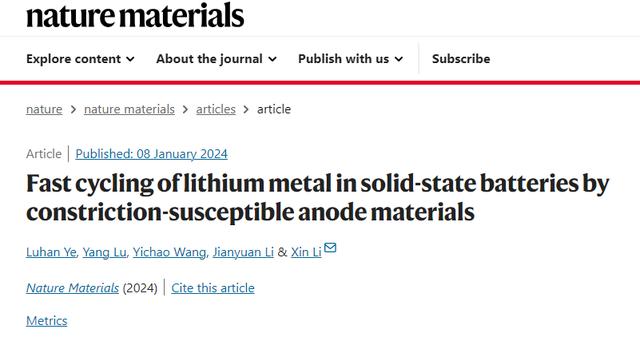 |
Welcome To Evlithium Best Store For Lithium Iron Phosphate (LiFePO4) Battery |
 |

Recently, researchers from the Harvard John A. Paulson School of Engineering and Applied Sciences (SEAS) in the United States have developed a new type of lithium metal battery that can undergo charging and discharging cycles for at least 6000 times, surpassing any other pouch-type batteries. Furthermore, these batteries can be charged in a matter of minutes.
This research not only outlines a novel method for manufacturing solid-state batteries using lithium metal anodes but also provides new insights into the materials for these potentially revolutionary batteries. The latest findings have been published recently in the journal "Nature Materials."
Xin Li, an associate professor of materials science at SEAS and a senior author of the paper, stated, "Lithium metal anode batteries are considered the holy grail of batteries because their capacity is ten times that of commercial graphite anodes, significantly increasing the driving range of electric vehicles. Our research is a crucial step towards more practical solid-state batteries in industrial and commercial applications."
As is widely known, one of the major challenges in designing these batteries is the formation of dendrites on the surface of the anode. These structures grow like roots in the electrolyte, piercing through the barrier separating the anode and cathode, leading to battery short circuits or even fires.
In 2021, Li and his team addressed this challenge by designing a multi-layered battery that incorporates different materials with varying stabilities between the anode and cathode, providing a method to deal with dendrites. This multi-layer, multi-material design doesn't completely prevent the infiltration of lithium dendrites but rather controls and contains them.
In this new study, the team utilized micrometer-sized silicon particles in the anode to shrink the lithium-ion reaction and promote uniform electroplating of thick lithium metal layers, thereby preventing dendrite formation.
In this design, as lithium ions move from the cathode to the anode during the charging process, the lithium-ion reaction is limited on the shallow surface, with ions attaching to the surface of silicon particles but not penetrating further.
This is markedly different from the chemical nature of liquid lithium-ion batteries, where lithium ions penetrate through deep lithium-ion reactions, eventually damaging the silicon particles in the anode. In solid-state batteries, the ions on the silicon surface are compressed and undergo the dynamic process of lithium-ion reactions, forming a lithium metal coating around the silicon core.
Li explained, "In our design, lithium metal is encapsulated around silicon particles. These coated particles form a uniform surface, ensuring an evenly distributed current density, preventing dendrite growth. Moreover, because electroplating and stripping can occur rapidly on a flat surface, the battery can be fully charged in just 10 minutes."
In experiments, researchers manufactured a stamp-sized pouch-type battery, which is 10 to 20 times larger than most coin cells produced in university labs. This battery maintained 80% capacity after 6000 cycles, surpassing other pouch-type batteries currently available in the market.
Reportedly, this technology has been licensed to the battery technology company Adden Energy by the Harvard Office of Technology Development. The company has scaled up this technology for manufacturing pouch-type batteries the size of smartphones.